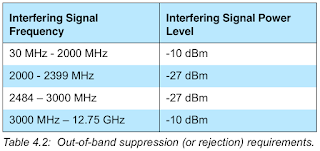Using Bluetooth to Debunk the Dual 5 GHz Myth
What does Bluetooth have to do with 5 GHz Wi-Fi? Nothing. Bluetooth operates in the 2.4 GHz frequency band.
If you look in the right spot, however, Bluetooth can teach you something about 5 GHz Wi-Fi. Specifically, the Bluetooth 5.0 specification can teach you that Dual 5 GHz access points are a bad idea.
This blog's opposition to Dual 5 GHz access points (APs) is not news to long time readers. The 'Two Radios Are Better Than One (Unless They're Both 5 GHz)' blog post, which details how Dual 5 GHz APs (like Cisco 3800 Series APs, for example) make enterprise Wi-Fi less stable, is nearly three years old.
Today's re-stating of the pitfalls of dual 5 GHz radio APs is due to something I uncovered while reading about Bluetooth. I was reading the Bluetooth 5.0 specification in search of anything that might affect Wi-Fi when I happened upon this table:
***
If you look in the right spot, however, Bluetooth can teach you something about 5 GHz Wi-Fi. Specifically, the Bluetooth 5.0 specification can teach you that Dual 5 GHz access points are a bad idea.
This blog's opposition to Dual 5 GHz access points (APs) is not news to long time readers. The 'Two Radios Are Better Than One (Unless They're Both 5 GHz)' blog post, which details how Dual 5 GHz APs (like Cisco 3800 Series APs, for example) make enterprise Wi-Fi less stable, is nearly three years old.
Today's re-stating of the pitfalls of dual 5 GHz radio APs is due to something I uncovered while reading about Bluetooth. I was reading the Bluetooth 5.0 specification in search of anything that might affect Wi-Fi when I happened upon this table:
The middle rows of the table is most dramatic, showing that out-of-band RF activity can interfere with the 2.4 GHz band at signal levels as low as -27 dBm.
It is the top and bottom rows of the table that relate to Dual 5 GHz APs. Those rows show that RF signals further away from the 2.4 GHz band may interfere, if those interfering signals are above -10 dBm.
The problem with Dual 5 GHz APs is that two 5 GHz radios are within the same AP, and thus very close to one another. With two 5 GHz radios so close to one another, the chances of signals reaching levels above -10 dBm are likely; perhaps assured.
5 GHz channels 36 and 149 may seem far apart. In some respects, they are: Channel 36 is centered at 5.180 GHz and channel 149 is centered at 5.745 GHz, which means 565 MHz of frequency space between channels. The problem is that, when Dual 5 GHz APs are used, the close proximity of the two radios makes it so that busy Wi-Fi networks will be unstable. And nobody -- not users, not support folks, and not admins -- likes unstable Wi-Fi.
If you like my blog, you can support it by shopping through my Amazon link. Thank you.
Twitter: @Ben_SniffWiFi
Twitter: @Ben_SniffWiFi
ben at sniffwifi dot com

Interesting topic and article ! Aruba did an interesting benchmark on a Cisco dual 5GHz AP vs a dual band Aruba AP a while back. At that time it supported the claim of dimishing bandwith returns using dual 5GHz
ReplyDeletehttp://community.arubanetworks.com/t5/Technology-Blog/Does-the-Dual-5GHz-Story-Stand/ba-p/271720
I was some years back doing conference solutions using the large Xirrus arrays with 8 and 16 sectorized antennas. Their secret sauce was the alleged effective isolation between multiple sectors in the same housing. Having a central high capacity AP mounted high above the clients is however no longer the recommeded solution
I would agree. Definitely best to avoid having multiple AP radios in one "box".
DeleteThat chart is relative to 2.4 Ghz devices; it can't be extrapolated out to 5.8 GHz devices as you're using it. As best I can tell, you're reading those signal levels backwards. -10 dBm is a much stronger received signal than -27 dBm, though both are whoppingly strong. That chart perfectly illustrates the effect of band-pass filtering. Any 2.4 GHz device will be designed to reject signals outside of its operating range which is why that chart shows it takes a *stronger* signal above and below the 2.4 band to cause problems.
ReplyDeleteWhatever signal rejection characteristics a device such as a 5.8 GHz AP might have are specific to itself alone, not other equipment, not the depicted chart.